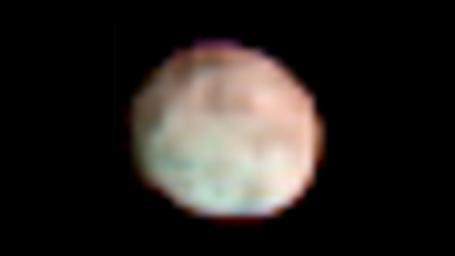Vesta in the Infrared
Caption:
This global, colorized image of the giant asteroid Vesta from NASA's Dawn mission reveals how the minerals are distributed on the surface. Infrared data from Dawn's visible and infrared mapping spectrometer show Vesta has more large-scale variations in surface material than other asteroids. The northern and equatorial regions, which appear reddish in the spectrometer data, stand in stark contrast to the southern regions, which appear bluish. The composition of the surface in these regions is therefore different. The bluish southern areas represent layers deep below the surface, from the lower crust. Analysis of spectrometer data reveal that the reddish areas are more dominated by rocks that formed volcanically and are richer in iron.
The visible and infrared mapping spectrometer onboard Dawn collects reflected and emitted radiation in a broad range of wavelengths. This colorized image uses three of the instrument's 864 channels.
This image was taken on June 30, 2011, during Dawn's approach to Vesta, from an altitude of about 62,000 miles (99,000 kilometers).
Background Info:
The Dawn mission to Vesta and Ceres is managed by NASA's Jet Propulsion Laboratory, a division of the California Institute of Technology in Pasadena, for NASA's Science Mission Directorate, Washington. UCLA is responsible for overall Dawn mission science. The visible and infrared mapping spectrometer was provided by the Italian Space Agency and is managed by the Italy's National Institute for Astrophysics, Rome, in collaboration with Selex Galileo, where it was built.
More information about Dawn is online at
http://www.nasa.gov/dawn
and
http://dawn.jpl.nasa.gov
.
Cataloging Keywords:
| Name |
Value |
Additional Values |
| Target |
4 Vesta |
|
| System |
Main Belt |
|
| Target Type |
Asteroid |
|
| Mission |
Dawn |
|
| Instrument Host |
Dawn |
|
| Host Type |
Orbiter |
|
| Instrument |
Visible and Infrared Spectrometer (VIR) |
|
| Detector |
|
|
| Extra Keywords |
Color, Infrared, Volcano |
| Acquisition Date |
|
| Release Date |
2012-05-10 |
| Date in Caption |
2011-06-30 |
|
| Image Credit |
NASA/JPL-Caltech/UCLA/INAF |
| Source |
photojournal.jpl.nasa.gov/catalog/PIA15668 |
| Identifier |
PIA15668 |

 Planetary Data System
Planetary Data System
